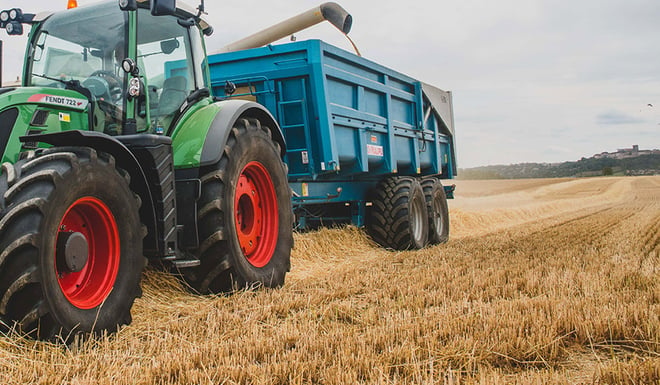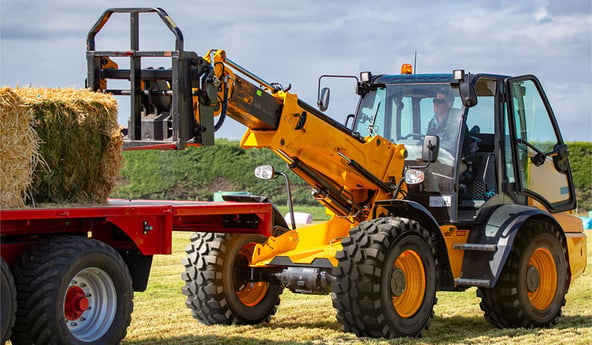Harvest is nearly here; you have just inspected your trailer tyres which have been resting all winter.
You may have noticed that they will soon need to be changed, but you don’t know which tyres to replace them with.
Here are a few indications to determine which agricultural tyres will be best suited to your trailer and to other machines such as your sprayer or slurry tanker.
What are the specific features of agricultural trailer tyres?
Trailer tyres are different to those of tractors or other self-propelled farm machinery as they do not provide tractive force. They are simply load-bearing.
As such, their importance is sometimes underestimated in relation to the tyres of drive wheels. But choosing the tyre for farm trailers is just as important as choosing those of your tractor. Using unsuitable tyres will cause soil compaction and will be detrimental to your productivity. This is even more important because, during harvesting or spraying, you will be driving over large areas of your field.
REQUIREMENTS FOR TRAILER TYRES
They must be able to carry heavy and varying loads (loading/unloading cycle) and drive at varying speeds. In the same day, trailers may have to drive fast on the road and slowly in the fields. These two different types of use put different demands on the tyre.
- Driving in the field the tyre must avoid soil compaction and rut creation, which involves increasing the contact surface area with the ground and/or reducing the tyre pressure (see our article: agricultural tyre pressure).
- On the road the tyre must have a low rolling resistance to reduce the power required by the tractor and reduce fuel consumption.
Which type of agricultural tyre should you choose? Radial or diagonal?
The first stage is to choose the type of tyre that you are going to buy, i.e. either radial or diagonal tyres.
- Radial tyres are more flexible, and can distort more, allowing for a good distribution of the load on the ground and less damage to crops. Thanks to their flexibility, they absorb more vibrations and are therefore more comfortable. This is an important element to consider as some periods (harvesting, silaging…) are extremely intense and you will be working very hard and for long hours. Optimum comfort will help you to reduce fatigue.
- Diagonal tyres will be more suitable if your terrain is bumpy or sloped, diagonal tyres will be more suitable as the rigidity of their sidewalls makes them more resistant and more stable.
TYRE SIZES
To limit the impact of the circulation of trailers in your fields, choose larger, low pressure tyres (often called floatation tyres).
The tyre’s width enables you to distribute heavy loads and the large volume of air that it contains enables you to increase its permitted load without increasing the pressure. As the pressure on the ground is in correlation with the tyre pressure, lower pressure will limit soil compaction.
AGRICULTURAL TYRE PROFILES
Trailer tyres have profiles that are specific and quite different from one manufacturer to another:
- Block structure tyres: some tyres do not have deep lugs like those on drive wheels, instead they have a block structure tread. This shape provides good road performance but may have more difficulties for self-cleaning than normal lug tyres, this can potentially bring a lot of mud onto the road when leaving a field. However, constructors keep coming up with technologies to try to overcome this problem.
- Lug tyre: other tyres use the lug tread system for good performance in the field and self-cleaning properties. For transport, these tyres can wear down more quickly than block structure tyres if used intensively on the road.
- Mixed tyre: some tyres use a mixture of lugs and blocks to compromise between field and road use. In this case, the blocks are usually placed in the centre and the lugs on the outside.
It is essential, when choosing your tyres, to consider the ratio of time spent on transport or in the fields so that you choose the profile most suitable to your needs.
ADAPT THE LOAD INDEX AND SPEED RATING TO YOUR USAGE
The load index is generally a number between 100 and 200, which corresponds to the load admissible per tyre for a given pressure level. The speed ratio is a letter corresponding to the speed at which the tyre can be used. You need to calculate these codes to choose the most suitable tyres for your usage. To do this, use the manufacturer’s load index and speed ratio table.
Tractor tyre weight and load index correlation table
| L.I. | kg | L.I. | kg | L.I. | kg | L.I. | kg | L.I. | kg |
| 73 | 365 | 74 | 375 | 75 | 387 | 76 | 400 | 77 | 412 |
| 78 | 425 | 79 | 437 | 80 | 450 | 81 | 462 | 82 | 475 |
| 83 | 487 | 84 | 500 | 85 | 515 | 86 | 530 | 87 | 545 |
| 88 | 560 | 89 | 580 | 90 | 600 | 91 | 615 | 92 | 630 |
| 93 | 650 | 94 | 670 | 95 | 690 | 96 | 710 | 97 | 730 |
| 98 | 750 | 99 | 775 | 100 | 800 | 101 | 825 | 102 | 850 |
| 103 | 875 | 104 | 900 | 105 | 925 | 106 | 950 | 107 | 975 |
| 108 | 1,000 | 109 | 1,030 | 110 | 1,060 | 111 | 1,090 | 112 | 1,120 |
| 113 | 1,150 | 114 | 1,180 | 115 | 1,215 | 116 | 1,250 | 117 | 1,285 |
| 118 | 1,320 | 119 | 1,360 | 120 | 1,400 | 121 | 1,450 | 122 | 1,500 |
| 123 | 1,550 | 124 | 1,600 | 125 | 1,650 | 126 | 1,700 | 127 | 1,750 |
| 128 | 1,800 | 129 | 1,850 | 130 | 1,900 | 131 | 1,950 | 132 | 2,000 |
| 133 | 2,060 | 134 | 2,120 | 135 | 2,180 | 136 | 2,240 | 137 | 2,300 |
| 138 | 2,360 | 139 | 2,;430 | 140 | 2,500 | 141 | 2,575 | 142 | 2,650 |
| 143 | 2,725 | 144 | 2,800 | 145 | 2,900 | 146 | 3,000 | 147 | 3,075 |
| 148 | 3,150 | 149 | 3,250 | 150 | 3,350 | 151 | 3,450 | 152 | 3,550 |
| 153 | 3,650 | 154 | 3,750 | 155 | 3,875 | 156 | 4,000 | 157 | 4,125 |
| 158 | 4,250 | 159 | 4,375 | 160 | 4,500 | 161 | 4,625 | 162 | 4,750 |
| 163 | 4,875 | 164 | 5,000 | 165 | 5,150 | 166 | 5,300 | 167 | 5,450 |
| 168 | 5,600 | 169 | 5,800 | 170 | 6,000 | 171 | 6,150 | 172 | 6,300 |
| 173 | 6,500 | 174 | 6,700 | 175 | 6,900 | 176 | 7,100 | 177 | 7,300 |
| 178 | 7,500 | 179 | 7,750 | 180 | 8,000 | 181 | 8,250 | 182 | 8,500 |
| 183 | 8,750 | 184 | 9,000 | 185 | 9,250 | 186 | 9,500 | 187 | 9,750 |
| 188 | 10,000 | 189 | 10,300 |
Table of speed ratings
| SPEED CODE | SPEED (in km/h) | SPEED CODE | SPEED (in km/h) | |
| A1 | 5 | B | 50 | |
| A2 | 10 | C | 60 | |
| A3 | 15 | D | 65 | |
| A4 | 20 | E | 70 | |
| A5 | 25 | F | 80 | |
| A6 | 30 | G | 90 | |
| A7 | 35 | |||
| A8 | 40 |
The speed code indicates the speed possible for a load corresponding to the load index in the conditions of use specified by the manufacturer.
In all cases, for optimum use of your tyres, be sure to adapt the pressure according to the manufacturer’s information and to monitor this pressure regularly.
SPECIFIC CASE OF DRIVE WHEELS ON TRAILERS
With increasing trailer sizes, drive axles are beginning to be developed on trailers. This distributes the tractive force between the tractor and the trailer. In this case, as for the tractor trailer, you will need to choose the tyres with a profile best adapted to traction.
The Bridgestone-agriculture.eu blog is written and administered by tractor tyre experts who are available to provide you with the advice you need on the subject of your agricultural tyres. They allow you to maximise your productivity with information on all subjects linked to tyres: Technical data for agricultural tyres – Agricultural tyre performance – Air pressure advice, Solutions to avoid soil compaction – Sprayer tyre pressure – Why and how to ballast your tractor tyres – etc….
To take it one step further and increase the profitability of your farm, les Experts du pneu provide a free, highly detailed eBook which explains the essential role of the agricultural tyre in your productivity.
Most people who read this article have also read some of the following articles which are listed by order of popularity:
This information is intended only to make you aware of the technical and functional aspects of agricultural tires and their use. It does not allow you to make a judgment or a definitive conclusion on a given problem. Only your agricultural tire expert is able to make a technical assessment and take a final decision, case by case.
Leave a
commentary
Your email address will not be published.
Required fields are indicated with *








